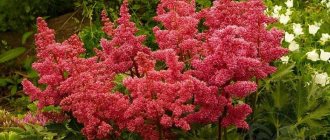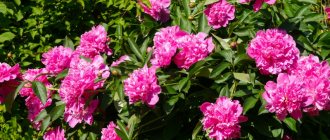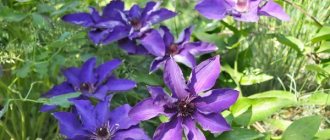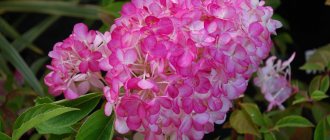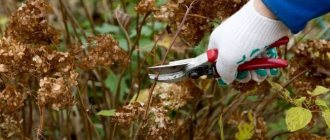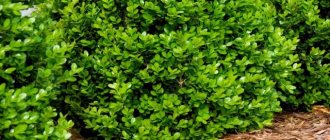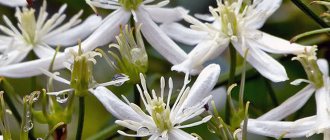When to cover hydrangea for the winter in the regions, timing
Work on covering the large-leaved hydrangea begins at a time when the first reports of sub-zero temperatures begin to appear in the autumn forecasts of weather forecasters. It is clear that in Russia this happens at different times, therefore, the timing of the shelter will vary.
It must be remembered that different types of hydrangea: tree-like, large-leaved or paniculate, differ in their winter hardiness and not all of them require the same care when preparing for winter.
Brief comparative characteristics of winter hardiness of hydrangea species
| Type of hydrangea | Coloring of inflorescences | Features of flowering | Winter hardiness |
| Hydrangea | White | On the growth of the current season | High, up to -30⁰С |
| Hydrangea paniculata | Pink or white | On the growth of the current season | Very high, from -35⁰С to -40⁰С |
| Hydrangea largeleaf | Pink, white, blue, lilac | On the runaways of last year | Low, up to 15-18⁰С |
When to cover hydrangea in the Moscow region
In the Moscow region and central Russia, work should start in mid-October, it is at this time that night temperatures begin to drop below zero, and there is a danger of flower buds freezing.
On a note. The inflorescences on large-leaved hydrangea appear on last season's shoots, so it is so important to keep them intact.
Other types of hydrangeas, tree and paniculate, bloom flowers on shoots that grow in the coming season, so the arrival of cold weather cannot negatively affect the number of inflorescences. In addition, the last two species have good winter hardiness, and it will be quite good to mulch the soil in the area where the root system is located.
When to cover hydrangea in the Leningrad region
The snowy winters of the Leningrad region cover hydrangea bushes with a warm blanket of snow, which becomes a natural protection for the paniculate and tree-like varieties of the flower. But with regard to large-leaved hydrangea, the rules of shelter cannot be neglected and work begins, approximately, in mid-autumn.
On a note. All hydrangeas, regardless of type and under three years old, must be covered for the winter.
When to cover hydrangeas in Siberia
It is very difficult to grow, and even more so to preserve, large-leaved hydrangea in the harsh climatic conditions of Siberia. In this region, paniculate hydrangea is better suited for growing in open ground, which should still be covered with the arrival of cold weather (despite its frost resistance). Otherwise, Siberian frosts will leave the amateur gardener without the luxurious bloom of such a charming flower.
In this region, large-leaved hydrangea is recommended to be grown in pots, which allows the plant to be moved indoors or into a heated greenhouse as cold weather approaches.
When to cover hydrangea in the Urals
The winters of the Ural region are somewhat milder, but they also require very careful preparation of large-leaved hydrangea for the winter period. It is necessary to prepare covering materials in advance and at the beginning, at the latest in mid-October, begin to insulate the flowers.
On a note. If the winter turned out to be particularly frosty and in the spring you find frozen tips of shoots on a paniculate or tree-like hydrangea - don’t worry, just cut them back to the first living pair of buds. The abundance of flowering will not suffer at all from this.
Growing
Large-leaved hydrangea is a heat-loving plant. It is susceptible to low temperatures. Sheltering large-leaved hydrangea for the winter is a prerequisite for growing. The plant can be planted in the ground in spring and autumn. The soil needs to be fertilized before planting. And what - it depends on its composition. If the soil is alkaline, it is necessary to add acidic peat. Hydrangea prefers clayey, red soil soils. Before planting hydrangea in the ground, be it in autumn or spring, you need to shorten the roots, and in spring planting, also young shoots. Only a few pairs of buds remain.
Hydrangea is planted at a distance of one meter from one bush to another. The holes are not deep, thirty centimeters is enough, since the root system of the plant is branched, but not deep. One-third of a bucket of humus is poured into each planting place. After planting, the hydrangea needs to be watered abundantly and the soil mulched with rotted manure.
How to cover large-leaved hydrangea
To protect garden plants from freezing, improvised materials and purchased non-woven materials used for arranging greenhouses are used.
Spruce spruce branches
Excellent natural material that can be collected in the nearest forest. Of course, this does not mean that you need to break off or cut down branches from the tree. There are enough of them lying on the ground, broken by wind and bad weather. And it’s very good if coniferous trees grow on your site. The branches remaining from the formative pruning will serve for the benefit of the flower garden.
However, one spruce branch is not enough. It is used in combination with other natural materials.
Conifer needles
In the same spruce forest you can collect several bags of coniferous litter. The ground is literally covered with coniferous needles, and you will not cause much harm to the spruce forest if you borrow from the forest the material so necessary for covering hydrangeas.
But this type of shelter also cannot be the only one when preparing plants for the winter.
Foliage
Fallen leaves from oak, chestnut or maple are harvested in advance and kept under a canopy so that they remain dry. In the shelter it is combined with spruce branches and non-woven materials.
Lutrasil, spunbond
Such materials, produced specifically for use in agriculture (and not only) serve as reliable protection against sudden temperature changes. Agrofibre allows air to pass through well, which does not expose the plant to oxygen starvation.
To cover large-leaved hydrangea for the winter, it is also used in combination with natural materials. Combining different components in an insulating structure increases the percentage of plant safety.
On a note. Similar to agrofibre, you can use burlap.
Polyethylene film
Many gardeners, in the old-fashioned way, use plastic film on their plots, and it is really good for covering hydrangeas for the winter. Even the fact that it does not allow air to pass through is not critical, because... hydrangeas are not afraid of high humidity.
The only thing you need to remember is:
- in early autumn, do not make the film shelter blank, but leave the side walls open for better aeration;
- in the spring, when the sun becomes more active, the film cover is immediately removed to avoid overheating of the plants. Other layers are left untouched until positive temperatures occur.
Hydrangea opening is carried out in stages. The last layer is removed after the end of return frosts.
Advice from experienced gardeners
And some valuable recommendations from experienced gardeners:
- Recently, winters, especially in the middle zone, have been quite unstable. And after frosts, thaws can occur. If this happens, do not forget to slightly open the material that protects the garden hydrangea. Heat and moisture inside the covering structure can create favorable conditions for the bush to rot. Therefore, ventilation is mandatory.
- It is best to carry out spring sanitary treatment of hydrangeas not after removing the covering material, but in late spring after the appearance of buds and young leaves. At this time, the sap flow will already stabilize, and the plant will not experience any inconvenience.
- In order not to injure the hydrangea while tying the shoots, it is better to take old tights or knee socks rather than ropes. Such elastic ties will not harm the shoots.
If someone does not dare to get this plant because of the fear of losing it in winter and difficulties in covering the hydrangea, it is worth noting: the bushes become more and more cold-resistant with age. This is due to the lignification of shoots. And for some frost-resistant varieties, after a few years, ordinary hilling of the roots is enough.
Preparatory work before shelter
In order for large-leaved hydrangea to safely survive the winter, it is necessary to carry out a number of preparatory measures in early autumn that will help the plant naturally increase its protective qualities.
- Preparation begins with sanitary cleaning of the bush. Damaged and diseased shoots are removed. Formative pruning is carried out on paniculate and tree hydrangeas. The shoots growing inside the bush are cut into rings. Tree trunks older than four years are cut out. On large-leaved hydrangeas, only sanitary and anti-aging pruning is carried out. The sections are treated with garden varnish or other protective agent that prevents the penetration of microbes into the living tissue of the plant. Young growths of the current year cannot be touched, because... they contain buds for flowering next season.
- Closer to autumn, hydrangeas are fertilized with phosphorus-potassium fertilizers, this helps protect against sudden changes in temperature, strengthens the root system, increases immunity and resistance to diseases. The composition of the feeding may be as follows: 1 tbsp. superphosphate and the same amount of potassium sulfate are dissolved in 10 liters of water. Organic fertilizers are applied in dry form and evenly distributed over the area of the tree trunk circle.
- Watering stops completely from mid-September, and if autumn turns out to be excessively rainy, then it would be useful to install a frame over the flower and stretch plastic wrap.
- It is known that mature, lignified shoots are more resistant to low temperatures and, in order to speed up this process, at the end of August - beginning of September, all leaves are removed from the shoots of large-leaved hydrangea, leaving only a few at the very top. They will serve as additional protection for flower buds. The process of shoot ripening has begun, as the plant will redirect all its forces to these purposes.
- Preventive autumn treatment of hydrangea against diseases and pests will help cope with pathogens and insects that have already managed to hide in the cracks of the bark or in the soil around the tree trunk. A 1% solution of Bordeaux mixture is suitable for these purposes. Treatment is carried out after leaf fall (or forced removal).
Interim preparations for winter have been completed, and you can worry about preparing materials and choosing a method of shelter.
Preparation
Next, you need to prepare the hydrangea for shelter. There are no specific rules or regulations that need to be followed, but I will give you a number of recommendations that will make it easy for you to prepare your favorite plant for winter.
Trimming
Experienced gardeners know that it is necessary to prune hydrangeas only in the fall. In the spring, during pruning, too much sap may leak out, the plant may be seriously damaged, and if it is a young seedling, it may even die.
First you need to remove all broken or already damaged shoots. In this way, we will rid the plant of those parts that take too much nutrition without giving anything in return. Next, you need to get rid of those branches that are quite old (4 to 5 years). It is also necessary to remove those shoots that seem to grow inwards, but so-called stumps should not be left. These simple steps will help the plant produce stronger young shoots next season.
Around mid-September, try to remove leaves from the shoots so that they can ripen before the cold weather.
Top dressing
Everyone knows that in autumn the soil is depleted and contains few useful elements. Therefore, it is necessary to regularly add fertilizer to it. We recommend using fertilizers that contain phosphorus and potassium, since these fertilizers will be less toxic and more beneficial, since they are organic. In addition, the potassium content in the soil helps protect plants from cold weather. And phosphorus strengthens the immunity of plants, making them less susceptible to various diseases that are so common in the autumn.
Soil disinfection, pest control
It was already mentioned above that autumn is a time when there are many pathogenic organisms in the soil and air. They can bring a wide variety of diseases to plants, including their death. To avoid this, it is necessary to regularly clean the soil.
And if you know that your soil is contaminated with a certain type of bacteria, then you need to buy a product that will be directed specifically against them. This point should not be skipped under any circumstances. It is at this stage that you provide your plant with a beneficial habitat.
Ways to cover large-leaved hydrangea for the winter
There are quite a lot of ways to cover hydrangeas for the winter, and each gardener chooses the best one for himself, based on his own capabilities.
Multi-layer shelter
Any option for covering hydrangeas begins with mulching the tree trunk circle, which will eliminate contact of plant shoots with the soil and prevent the occurrence of unwanted diseases.
- The soil around the hydrangea is covered with a layer of pine litter, spruce branches, dry maple, chestnut or oak leaves. These types of foliage do not have time to rot during the winter, which also reduces the likelihood of disease.
- Hydrangea shoots are divided into 2 parts and tied. The ligaments are bent to the ground in opposite directions and pinned to the ground. Metal staples, bent thick wire, wooden slingshots, etc. can be used as pins. If the bush is voluminous, then the division is carried out into a larger number of parts, also bent to the ground and securely fixed.
If there is time and the gardener has a sufficient amount of fastening material, then each shoot can be fixed to the soil individually, drawing peculiar sun rays from the shoots.
- The root space is filled with moss or leaf litter, which will serve as additional protection for the root system from freezing.
- Low arcs are installed over the hydrangea and agrofibre is thrown over it. This will be the initial shelter for the period of light frosts.
- Then dry leaves, sawdust, and spruce branches are thrown onto the structure.
Install arcs of greater height and again stretch the agrofibre or polyethylene film. When using film, the ends of the shelter must be left open so that the plant can breathe - it is tightly secured when stable cold weather arrives.
On a note. Large-leaved hydrangea is a heat-loving plant and is not prone to damping off, so it is better to take protective measures in advance than to be late with them.
With the arrival of spring, the hydrangea is opened in stages, removing one layer after another at some intervals and depending on the weather.
Vertical shelter
This type of shelter for large-leaved hydrangea for the winter involves vertical insulation of the plant and for these purposes the following can be used: roofing felt, metal mesh, wooden pegs.
- The hydrangea bush is tied and wrapped with agrofibre. Roofing felt is installed around the plant, leaving a gap of at least 10 cm between its walls and the outer shoots. It is secured with twine in several places. The insulating material should rise 30-40 cm above the bush. The empty space is filled with dry leaves of oak, maple or chestnut, guided by the same properties of foliage - they are not subject to rapid decomposition. With the arrival of cold weather, the top of the structure is covered with non-woven material or film.
- A metal mesh frame is installed around a hydrangea bush tied and hidden under a covering material, and the voids are filled with dry leaves. You can put a piece of plywood on top and press it with something heavy (stone, brick).
- Wooden stakes are driven in around the perimeter of the plant and non-woven material is pulled around it. The voids are filled with dry insulating material. The top is also covered with agrofibre and secured to the sides. You can put a basket or box on small bushes.
On a note. When tying bushes, it is better to use soft, non-synthetic material to eliminate the possibility of damage to the shoots.
Covering hydrangeas with soil
A mulch layer is placed under the hydrangea bush to the length of the bent shoots. Hydrangea branches are tied in bunches of 4-5 pieces and pinned to the ground. Cover the top with non-woven material and add a layer of sawdust or foliage. Next comes the earth, 10-15 cm thick.
On warm autumn days, it is necessary to make an outlet in the ground for air circulation.
Botanical description
Most of the hydrangea species are shrubs with a height of 1 m to 3 m; among hydrangeas there are both trees and vines that climb tree trunks to a height of up to 30 m. Among the representatives of the genus there are evergreen species, and there are deciduous ones, but in our latitudes they are grown namely the latter, blooming from spring to late autumn. Two types of flowers are collected in spherical inflorescences at the ends of the stems - sterile at the edges and fertile in the middle of the inflorescence. The flowers are most often white, but a species such as large-leaved hydrangea is represented by varieties with pink, blue, lilac and red flowers, and the acidity of the soil determines the color of the specimen. For example, hydrangeas with blue flowers grow in acidic soil, lilac and pink flowers in alkaline soil, and soft beige flowers in neutral soil. The fruit of hydrangea is a multipartite capsule with seeds.
- Rockery on a summer cottage
In addition to large-leaved hydrangea, tree hydrangea grows well in our climate, known for its winter hardiness and ability to recover well from severe frosts. Paniculata hydrangea also overwinters well, known for its longevity - it can grow in one place for up to 60 years.
In addition to these three most popular species, such species as serrate hydrangea, serrate hydrangea, climbing hydrangea, radiant hydrangea, Sargent hydrangea, petiolate hydrangea, oakleaf hydrangea and others are known in floriculture.
Features of shelter for young hydrangea
Young hydrangeas require more care and attention when preparing for winter. Their shoots are still weak and fragile, so if you choose a sheltering method with bending to the ground, it is better to pin the shoots one at a time, carefully choosing directions.
The center of the tree trunk circle is covered with peat, sawdust or moss, a mound of 10-15 cm. A layer of dry leaves is poured on top, making sure that the shoot is evenly covered along its entire length, because the flower bud is located at the very top.
Spruce branches are laid on top of the foliage, which will serve as fasteners for foliage and additional shelter.
Agrofibre is laid on coniferous branches in 4-6 layers. It is impossible to overdo it here, because large-leaved hydrangea is a heat-loving plant and is not afraid of damping off. The edges of the nonwoven material are pressed to the ground with bricks along the entire perimeter.
This is interesting. You can change the shade of hydrangea inflorescences yourself by resorting to special dyes that are sold in flower shops. Depending on the desired color, the plant is watered with the solution 1-2 times a week. In addition, aluminum sulfate is suitable for these purposes, which will add blue, and potassium permanganate will give the flowers a pink tint.
Under natural conditions, on acidic soils, where the acidity level is lower than 5.5 units, hydrangea inflorescences are blue. In alkaline and neutral areas of the flower garden (pH = 6.5 and above), the hydrangea caps become pink or even red. In a slightly acidic environment (5.5-6.5) - the flowers acquire a lilac hue.
When to cover?
Hydrangea must be covered before the night temperature drops below 0 degrees, unless, of course, there is a thaw. You should carefully monitor the weather forecast.
If the upper branches are slightly frozen, they can be revived during spring pruning.
Each gardener must decide for himself how and with what to cover the hydrangea . The bush will easily survive the winter in warm latitudes, but in colder latitudes it may freeze slightly and will recover after pruning in the spring. Of course, young plants that have been planted in the ground for the first year from greenhouses or nurseries must be insulated. Hydrangea adapts well to climate, soil and weather conditions, so it becomes more hardy every year. If you pay maximum attention to the bushes in the first years of their life, they will delight you with color for many years to come.
Watch the video! How to cover a hydrangea with thick stems
